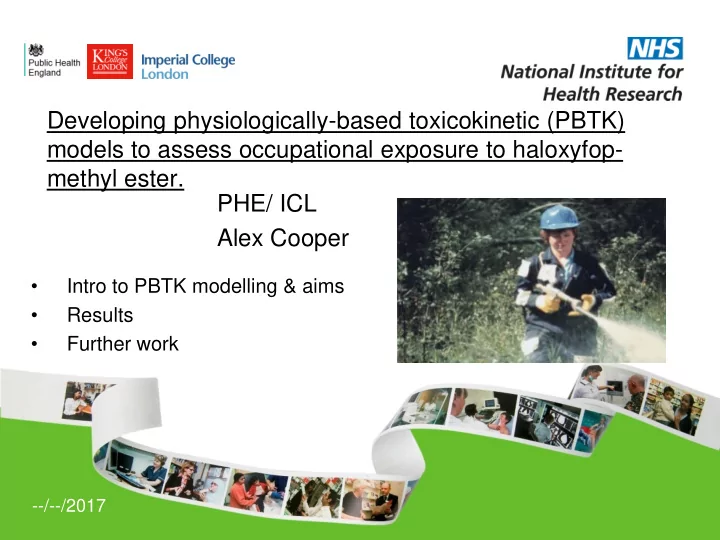

Developing physiologically-based toxicokinetic (PBTK) models to assess occupational exposure to haloxyfop- methyl ester. PHE/ ICL Alex Cooper • Intro to PBTK modelling & aims • Results • Further work --/--/2017
PBTK modelling
Project overview Construct rodent PBTK models for herbicides Calibrate parameters common to both species Calibrate models with rodent toxicokinetic data Calibrate Calibrate mouse- Exposure human- specific reconstruction specific Extrapolate models to parameters parameters humans Human Human Mouse biomonitoring data toxicokinetic toxicokinetic data data Exposure reconstruction with human biomonitoring data
Hypothesis & aims Hypothesis: PBTK models can be calibrated and used to accurately calculate tissue exposures for use in risk assessment. Aims: • To investigate if there are different biologically-plausible approaches to fitting toxicokinetic data in the same rodent PBTK model, and once extrapolated to humans, whether these have different implications for internal exposure assessment. • To reconstruct human external exposure, using a calibrated human PBTK model and human biomonitoring data. • To infer exposure in target tissues of interest using a calibrated human PBTK model.
Case study: haloxyfop-methyl ester peroxisome liver toxicity Inhibits proliferation (NOAEL is 0.5 mg/ Kg bw/ ACCase day) ÷ 100 Acceptable Operator Exposure Limit (AOEL) is 0.005 mg/ Kg/ day - AOEL is ‘the maximum internal (absorbed) amount of active substance to which operator may be exposed (from all absorption routes) without adverse health effects’ (European Commission) - expressed as internal levels (mg/ kg bw/ day)
Octanol: water partition coefficient (logP o:w ) for haloxyfop-P • assay performed to provide additional biochemical data for model calibration • performed as described in OECD (1995), and modified to resemble physiological conditions (37 ° C, using PBS pH 7.4 for aqueous layer). • No significant difference between both experimental conditions (p = 0.85,α = 0.05; n = 10). • QSAR value is 3.93!
Fit liver toxicokinetic data PPAR α Model liver receptor transporter activity binding (NO PPAR α receptor binding)
Maximum tissue exposure (individual C) Extrapolate from mouse (with PPAR α receptor binding) Concentration (ng/ g-tissue) Extrapolate from mouse (with liver transporter activity)
Risk assessment: Operator maximum systemic exposure Extrapolate from mouse (with PPAR α receptor binding) Dose (mg/ Kg bw) UK-POEM model AOEL German model A B C Extrapolate from mouse (with liver transporter activity) Dose (mg/ Kg bw) A B C
Take home message PBTK models can be calibrated and used to accurately calculate tissue exposures for use in risk assessment
Further work • Determine concentration ratio between human blood & plasma • Fraction unbound in human plasma • Partition coefficient between veg. oil & water • Assess exposure to brominated flame retardants
Thanks Tim Ebbels Matt Puncher Manoj Aggarwal Gwyn Lord Michael Bartels Tim Gant Claire Terry Tina Mehta www.nihr.ac.uk
Recommend
More recommend